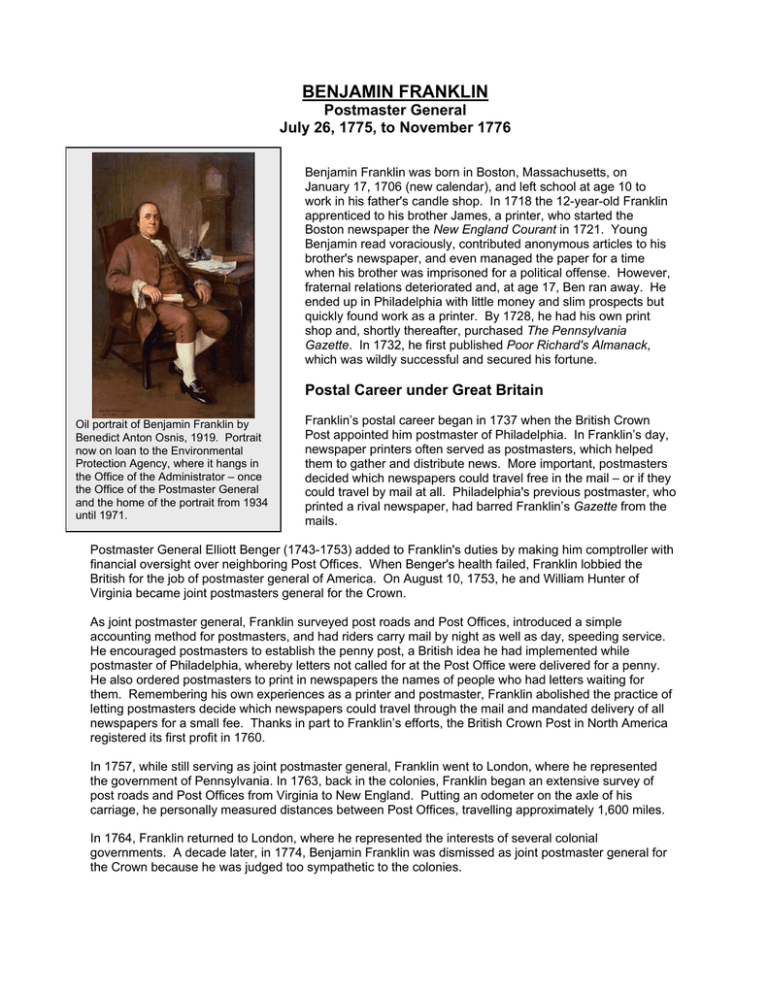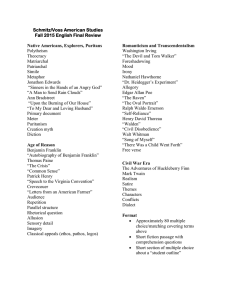benjamin franklin
advertisement

BENJAMIN FRANKLIN Postmaster General July 26, 1775, to November 1776 Benjamin Franklin was born in Boston, Massachusetts, on January 17, 1706 (new calendar), and left school at age 10 to work in his father's candle shop. In 1718 the 12-year-old Franklin apprenticed to his brother James, a printer, who started the Boston newspaper the New England Courant in 1721. Young Benjamin read voraciously, contributed anonymous articles to his brother's newspaper, and even managed the paper for a time when his brother was imprisoned for a political offense. However, fraternal relations deteriorated and, at age 17, Ben ran away. He ended up in Philadelphia with little money and slim prospects but quickly found work as a printer. By 1728, he had his own print shop and, shortly thereafter, purchased The Pennsylvania Gazette. In 1732, he first published Poor Richard's Almanack, which was wildly successful and secured his fortune. Postal Career under Great Britain Oil portrait of Benjamin Franklin by Benedict Anton Osnis, 1919. Portrait now on loan to the Environmental Protection Agency, where it hangs in the Office of the Administrator – once the Office of the Postmaster General and the home of the portrait from 1934 until 1971. Franklin’s postal career began in 1737 when the British Crown Post appointed him postmaster of Philadelphia. In Franklin’s day, newspaper printers often served as postmasters, which helped them to gather and distribute news. More important, postmasters decided which newspapers could travel free in the mail – or if they could travel by mail at all. Philadelphia's previous postmaster, who printed a rival newspaper, had barred Franklin’s Gazette from the mails. Postmaster General Elliott Benger (1743-1753) added to Franklin's duties by making him comptroller with financial oversight over neighboring Post Offices. When Benger's health failed, Franklin lobbied the British for the job of postmaster general of America. On August 10, 1753, he and William Hunter of Virginia became joint postmasters general for the Crown. As joint postmaster general, Franklin surveyed post roads and Post Offices, introduced a simple accounting method for postmasters, and had riders carry mail by night as well as day, speeding service. He encouraged postmasters to establish the penny post, a British idea he had implemented while postmaster of Philadelphia, whereby letters not called for at the Post Office were delivered for a penny. He also ordered postmasters to print in newspapers the names of people who had letters waiting for them. Remembering his own experiences as a printer and postmaster, Franklin abolished the practice of letting postmasters decide which newspapers could travel through the mail and mandated delivery of all newspapers for a small fee. Thanks in part to Franklin’s efforts, the British Crown Post in North America registered its first profit in 1760. In 1757, while still serving as joint postmaster general, Franklin went to London, where he represented the government of Pennsylvania. In 1763, back in the colonies, Franklin began an extensive survey of post roads and Post Offices from Virginia to New England. Putting an odometer on the axle of his carriage, he personally measured distances between Post Offices, travelling approximately 1,600 miles. In 1764, Franklin returned to London, where he represented the interests of several colonial governments. A decade later, in 1774, Benjamin Franklin was dismissed as joint postmaster general for the Crown because he was judged too sympathetic to the colonies. First Postmaster General under the Continental Congress Back on American soil in 1775, Franklin was part of the Second Continental Congress and served on many committees, including one to establish an independent postal system. On July 26, 1775, the Congress appointed Benjamin Franklin the first Postmaster General of the organization now known as the United States Postal Service. Franklin received an annual salary of $1,000 plus $340 for a secretary and comptroller. He was responsible for all Post Offices -- from Massachusetts to Georgia -and had authority to hire as many postmasters as he saw fit. First few lines of the index to Franklin's ledger of Post Office accounts, reproduced in 1976 as The Ledger of Doctor Benjamin Franklin, Postmaster General, 1776. The ledger, which was maintained by Franklin and his assistant and successor Richard Bache from 1775 to 1778, provides financial details on 72 Post Offices, listed in the index by the initial vowel in their name. Founding Father of a New Nation In the summer of 1776, Franklin worked with the committee that created the Declaration of Independence. In the fall, he left for Paris to secure French support for the war with England. Franklin entrusted the General Post Office to his son-in-law, Richard Bache, who was comptroller and his second in command. Benjamin Franklin's tenure as Postmaster General officially ended when Bache was appointed Postmaster General on November 7, 1776. Renowned for his scientific discoveries, Benjamin Franklin was by all accounts the most highly respected American in Europe and served the colonies well with his skilled diplomacy. The treaty of alliance he negotiated with France in 1778 proved vital to the success of the American Revolution. After the war, Franklin helped negotiate the peace treaty with Great Britain, which was signed on September 3, 1783. In 1785, Franklin returned to Philadelphia. He attended the Constitutional Convention in 1787 and lived to see the adoption of the Constitution of the United States of America in May 1789. Less than a year later, on April 17, 1790, Benjamin Franklin died. A postal pioneer, printer, writer, statesman, and diplomat, Franklin also was renowned as a civic leader, scientist, and inventor. He helped establish a library, fire company, college, philosophical society, militia for civil defense, and hospital, and he helped improve streets and street lighting in the city of Philadelphia. His scientific contributions included a study of electricity and lightning, theories of heat absorption, and the measurement of the Gulf Stream, and he invented the lightning rod, bifocals, and the Franklin stove. Centuries later, Franklin remains an internationally recognized figure, undiminished by time. Biographer Carl Van Doren wrote: In any age, in any place, Franklin would have been great. . . . [N]umerous as his achievements were, they were less than he was. To learn more about Benjamin Franklin: Butler, Ruth Lapham. Doctor Franklin, Postmaster General. Garden City, NY: Doubleday, Doran & Company, Inc., 1928. 200 pp. Clark, Ronald W. Benjamin Franklin: A Biography. New York, NY: Random House, 1983. 530 pp. Franklin, Benjamin. The Autobiography of Benjamin Franklin. New York, NY: Washington Square Press, 1955. 215 pp. Van Doren, Carl. Benjamin Franklin. New York, NY: The Viking Press, 1957. 845 pp. Images of Benjamin Franklin and George Washington were chosen to be on the first U.S. postage stamps, issued July 1, 1847. HISTORIAN UNITED STATES POSTAL SERVICE FEBRUARY 2003



